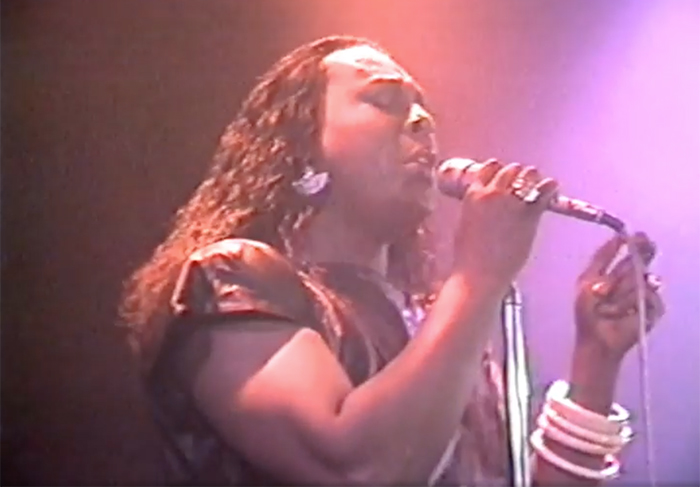Given Brighton’s unofficial status as the Gay Capital of the UK you might imagine there would be statues, monuments, or other public markers to support that status? I recently had the chance to see if that is the case…
On 13 April 2024 I took part in ‘A Monumental Weekend’ at The Ledward Centre – a workshop created by visual artist and designer Alexander Augustus. It was looking into LGBT+ monuments – their design and creation, and all the questions surrounding that, as well as the design and crafting of three potential pieces.
Alex asked me to give a brief talk about LGBT+ monuments in Brighton, so I looked into what currently exists, what used to exist, and what has been attempted but didn’t quite make it. This should not be considered be an exhaustive list although I did my best to cover everything I thought relevant.
To break it down I divided them into three categories:
- Plaques
Anything which has been dedicated to one or more people, usually famous and frequently in a very specific location. Given the range of plaques that exist I decided to split them up into four groups: corporation, personal, charitable and commercial. - Paintings
Anything from graffiti to murals and the like, again possibly marking an LGBT significant location. - Plinths
A general term for any sort of 3D artwork and / or public sculpture.
Unless stated otherwise the photos below were taken by me.
1. Plaques
I know I’m repeating myself but this covers anything which has been dedicated to one or more people, usually famous and frequently in a very specific location.
1.1 Corporation plaques
There are about 160 plaques in Brighton & Hove, installed over the last 100 years by a combo of the Brighton Corporation, Hove Corporation, and the Regency Society. They merged in 1997 into the Blue Plaque Panel which, outside of London, it is believed to be the oldest in the world. A bit of plaque trivia for you there. A number of ‘official’ blue plaques have LGBT+ connections, here are just a couple.
Edward Carpenter and George Merrell
Here is the plaque at 45 Brunswick Square, Hove, where Edward Carpenter was born in 1844. As well as an author and poet, he was a pioneering supporter of women’s rights and gay rights. His lover, George, inspired E M Forster to write his novel ‘Maurice’. Carpenter really should be far better known than he is, but I won’t stray onto my soapbox, although you can read more about Edward Carpenter and homogenic love here.

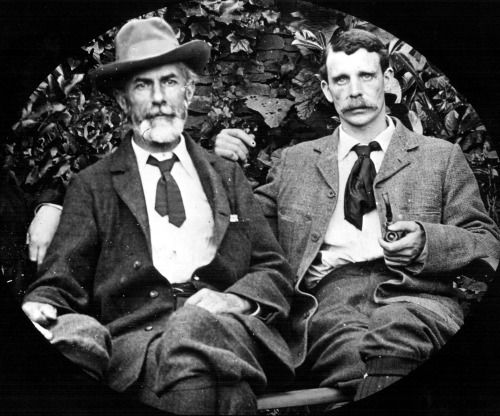
Photographer unknown.
Elizabeth Robins and Octavia Wilberforce
The next example is the plaque to Elizabeth Robins and Octavia Wilberforce. They can be seen here with one of the Jersey cows based for a time at their home, Backsettown House in Henfield, in the 1930s. I know it’s really random but the only photo I could find of the pair together came with a cow, for which you can thank or blame Henfield Museum!
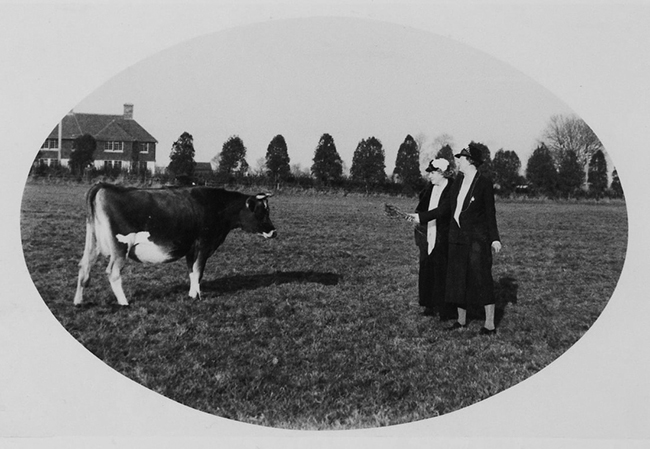
Backsettown became a women’s shelter and refuge for suffragettes, and the pair moved to 24 Montpelier Crescent around 1940 (now the Seven Dials Medical Centre). Robins was a suffragette, actress, writer (and a friend of Oscar Wilde), and Wilberforce a doctor. Wilberforce was friendly with the Bloomsbury Group and became Virginia Woolf’s doctor in the period leading up to her death.
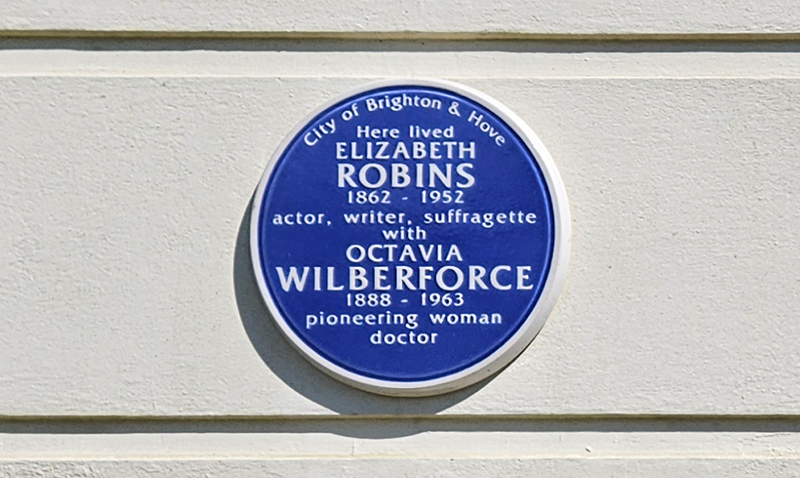
Some class their relationship as mother and daughter, others that of a loving couple. One of the issues with LGBT history is having to read between the lines about relationships that people have been forced to hide… but that’s a whole other blog post.
1.2 Personal plaques
DJ Andy Crock (1994)
This is the plaque on the Bartholomew Square end of Market Street, and says: ‘Dedicated to DJ Andy Crock Brighton’s clubland legend who tragically died March 15th 1994, from Use Your Loaf.’
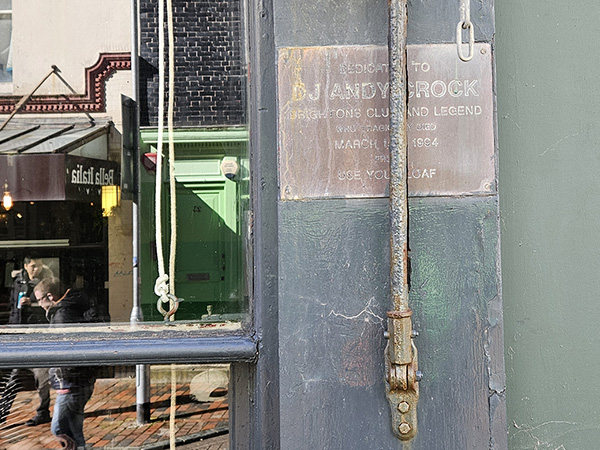
Just to clarify ‘Use Your Loaf’ had nothing to do with his demise, it was the name under which he promoted club nights based around big name DJs like Carl Cox, and Judge Jules. Apparently Andy’s nickname was ‘Janet’, and one flyer I found had him listed at the end of all these other DJs simply as ‘Janet, Your Local Woopsie’!
1.3 Charitable plaques
World AIDS Day (1996)
In the gardens behind the Brighthelm Centre there is a plaque embedded in a stone at the base of a silver birch tree. It reads: ‘The memories of you all are still with us, and the pain in our hearts, although eased in time, is forever on our minds. World Aids Day 1996’.
From what I can tell it was instigated by Open Door, a peer-led support centre for people with HIV/AIDS, created in 1988. It was unveiled by Ken Swaddling (aka Tall Ken), who had been part of Open Door since its inception.

If you’re wondering if an AIDS memorial counts as an LGBT monument, over 85% of all cases of HIV in Brighton were transmitted via men having sex with men, and given the amount of gay men in the town, at the peak of the pandemic Brighton’s infection rate was 12 times the national average. So I would argue it deserves to be included here.
If you’re wondering about Tall Ken, sadly we lost him in the late 1990s.
Sussex Gay Liberation Front (2001) never installed
The next plaque was created in 2001 to commemorate the Sussex Gay Liberation Front. Brighton Ourstory researched and staged an exhibition about the queer history of the University of Sussex – Queer About Campus – which included the Sussex GLF. This was the logo for that exhibition.
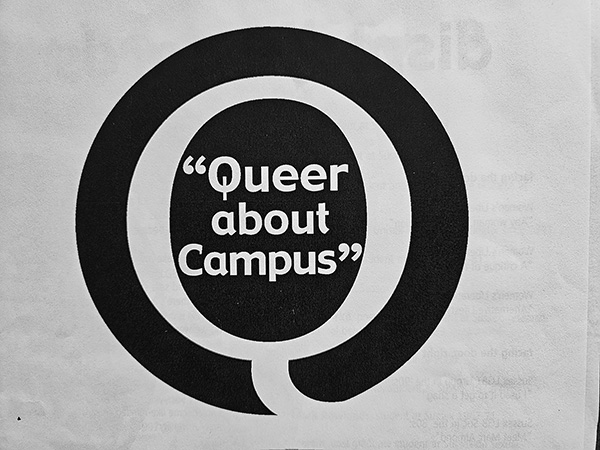
The Sussex GLF held their first meeting on the university campus in 1971, and a plaque (in the style of local blue plaques) was created by Brighton Ourstory. The University of Sussex were approached about installing it. I believe the plaque was eventually deemed to detract from the look of the buildings and its installation was declined. The plaque still exists I’m told, in storage with Brighton Ourstory, but I’ve been unable to gain access to take a photo of it.
1.4 Commercial plaques
The Walk of Fame (2001)
The stars of the Walk of Fame are engraved into stone slabs in the pavement down at Brighton Marina. Here we see Sir Terence Rattigan who also has a blue plaque at 79 Marine Parade (Bedford House) where Rattigan lived in the early 1960s. He was a playwright, a patron of Joe Orton and co-authored the screenplay of ‘Brighton Rock’ with Graham Greene. He had several male lovers but had to be discreet as it was of course illegal until 1967.
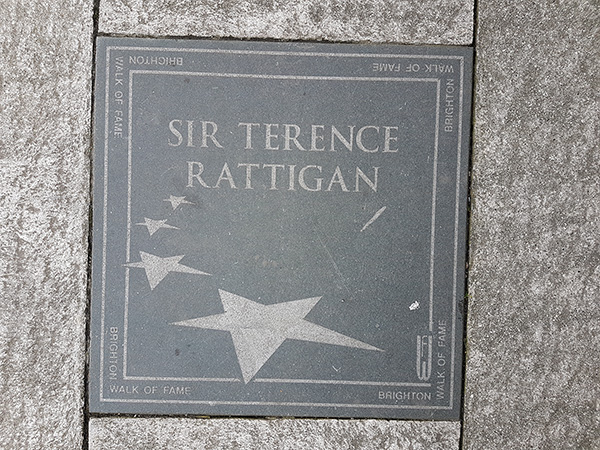
Apparently the comedian Julian Clary also has a star in the Walk of Fame, although I’m unsure of his local connection. Anyone know?
Brighton & Hove buses
Ok, I admit I’ve stretched the definition of plaques to breaking point here, but it is a hunk of metal with someone’s name on it! Anyway, lots of buses in Brighton are dedicated to people and their name(s) appear on the front of the vehicles. Here is the bus named after singer and 60s icon Dusty Springfield. By coincidence the whole names-on-buses thing began in 1999, the same year Dusty died, making her one of the first to be commemorated in this way.
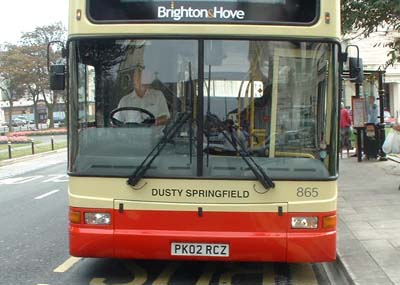
Image courtesy of Brighton & Hove Bus and Coach Company
Dusty Springfield had a strong local connection as her parents lived in Wilbury Ave in Hove, where she was often seen visiting them.
2. Paintings
Just to recap – this includes anything from graffiti to murals and the like, again possibly marking an LGBT significant location. It’s not something obvious but there have been a couple of relevant instances.
Unicorn Bookshop mural (1967) since removed
This mural was designed by John Upton for Bill Butler and his partner Mike Hughes who set up the Unicorn Bookshop at 50 Gloucester Road, which opened in 1967. Bill was a 6ft5 blonde American ex-marine, so he was a very noticeable figure around town. Bill and Mike were out and proud, at a time when that was extremely rare, but were actually more part of 60/70s hippie counterculture movement than the local gay scene.
Bill was a beat poet and together they set up the Unicorn Press. However, some of the stock in the shop was considered ‘obscene’ by local police and a legal battle ensued that made headlines in the national press. Struggling and failing to keep the bookshop out of financial crisis they moved to Wales around 1973.

The commemoration of the bookshop has actually continued after the original mural disappeared. Below you can see a 2017 reimagining of the mural with a unicorn near the window, stars to the left and sun to the right. This was painted by local artist Sinna One (who paints all the lost musical icons on the Prince Albert pub – where Banksy’s Kissing Coppers appeared), as part of an ongoing project by Kriya Arts to uncover and celebrate the stories of ordinary people and forgotten heroes.
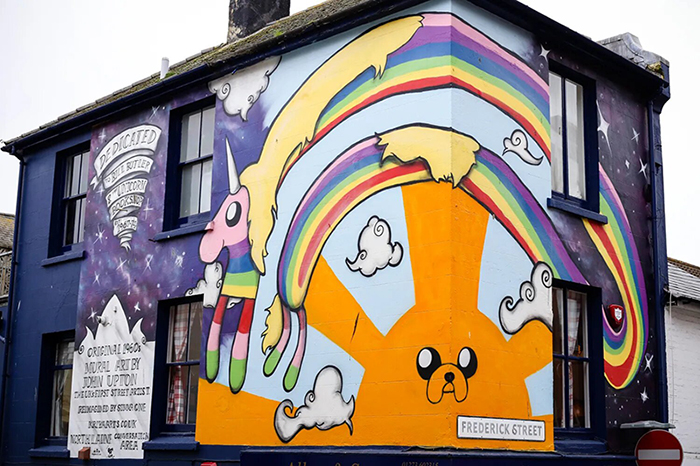
Bill Butler expert Don Lickley recently pointed out that even on the current mural for a coffee shop there is a unicorn by the same window, sun to the right, and stars on both the left and right of the design reflecting the original.
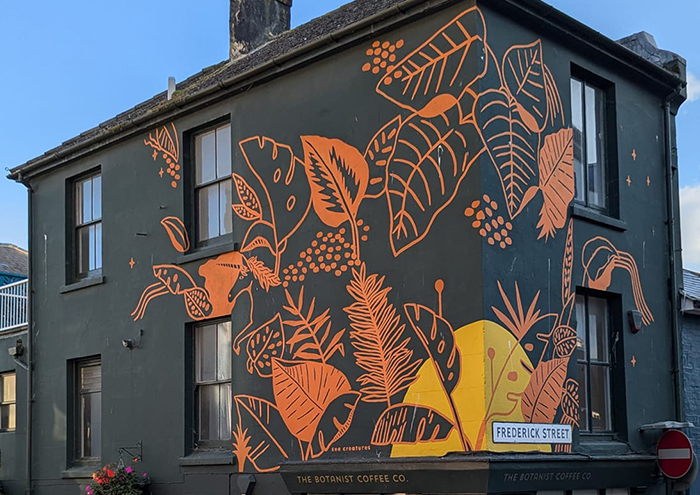
Banksy’s Kissing Coppers (2004)
The ‘Kissing Coppers’ graffiti by Banksy is / was on the Prince Albert pub at Frederick Place (off Trafalgar Street). According to Banksy’s website, its placement in Brighton was in recognition of the city’s LGBT population. However, the piece was subject to repeated vandalism, and damaged on more than one occasion.
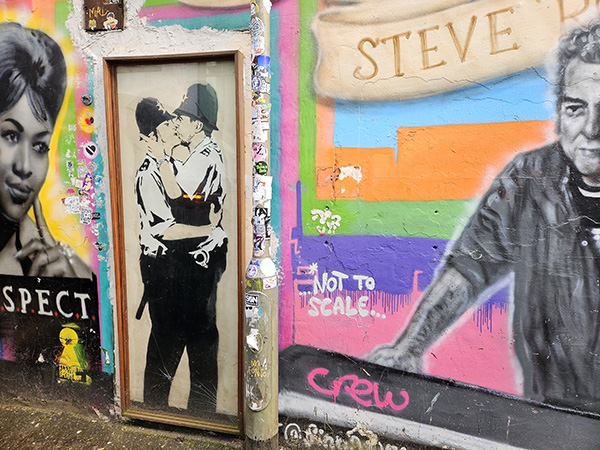
It was removed and transferred to canvas, with a replica taking its place (as seen above), in 2008. I have read that the pub’s owner sold the original artwork in 2014, for $575,000 (just under £455,000).
3. Plinths
If you read the intro (of course you did!), you’ll know I’m using this is a blanket term for any sort of 3D artwork and / or public sculpture.
Kiss Wall (1992)
The Kiss Wall by Bruce Williams at Grand Junction Road is a 4m high vertical aluminium column, pierced with small holes to create images when seen from the correct angle. The sculpture was the result of a competition by the council, offering £10,000 for a piece of artwork to be positioned anywhere in the city.
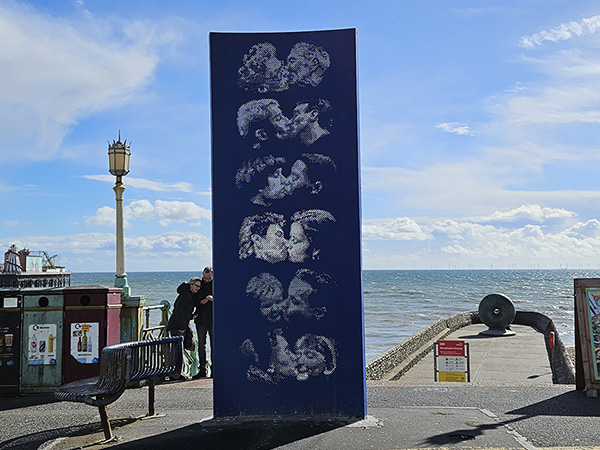
According to Bruce Williams’ website it illustrates the diversity of Brighton’s population, celebrating equality, understanding and acceptance between all individuals. You can see that the second and fourth couples from top are same sex snoggers. Bruce Williams himself said: “I think that variety showed the togetherness of all these people – just because they’re different doesn’t separate them, and I hope that idea carries on”.
Tay (2009)
Below you can see ‘Tay’ by Romany Mark Bruce, New Steine Gardens. It’s named after his friend Paul Tay who died of AIDS in 1992. The bronze sculpture depicts two figures, reflecting the shape of the AIDS ribbon.
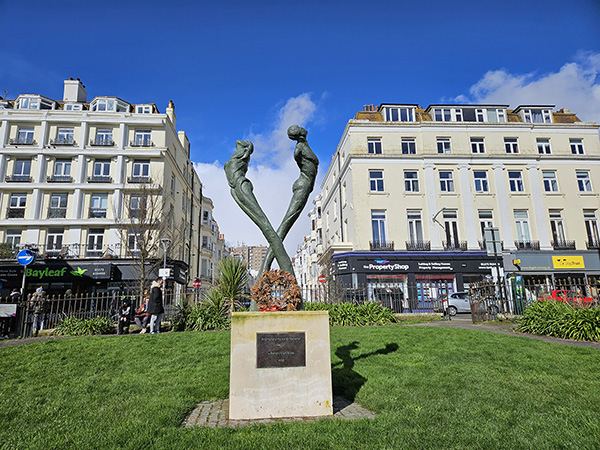
James Ledward, founder of GScene magazine, spearheaded a campaign for a public AIDS memorial in the city, and Bruce won the commission by public vote in 2007. Funding was obtained entirely through public donations – in fact so much money was raised that The Rainbow Fund was created – still the city’s central hub for LGBTQ+ fundraising.
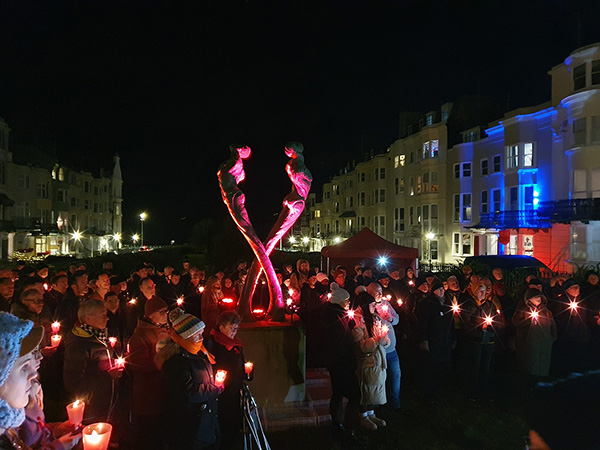
Every year since it went up, it’s been used as a gathering place on World AIDS Day, to remember those lost and those living with HIV/AIDS.
Pride memorial (1992) never realised
In 1992 details were released of a Pride memorial to be constructed at the Old Steine. The publicity material made it sound like a done deal:
“On Sunday the 17th of May 1992, Britain’s first permanent memorial to lesbians and gay men will be unveiled in the heart of Brighton. Brighton Council has pledged a central site on the Old Steine and agreed to install and maintain the memorial. The granite slabs from which it is to be made are ready for work to begin. The design and wording has been consulted on and approved. The memorial is a celebration of our pride over the last quarter of a century. It is dedicated to lives of ordinary lesbians and gay men who preceded us, to ourselves, and to the future equality of those who will follow us in this life.”
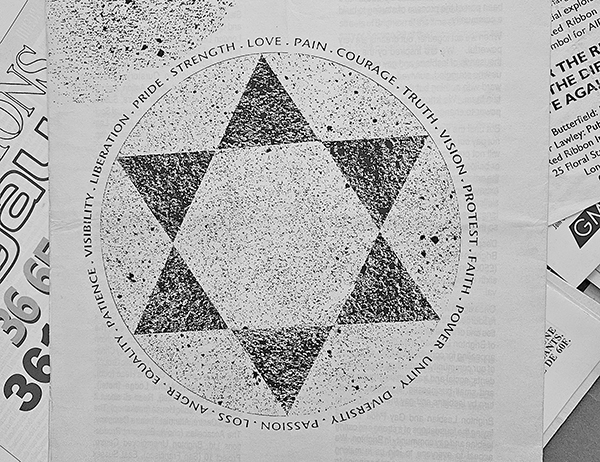
On 17 May 1992 the memorial was unveiled in floral form at a ceremony at the Old Steine, but this was as close as it ever came to existing in real life.
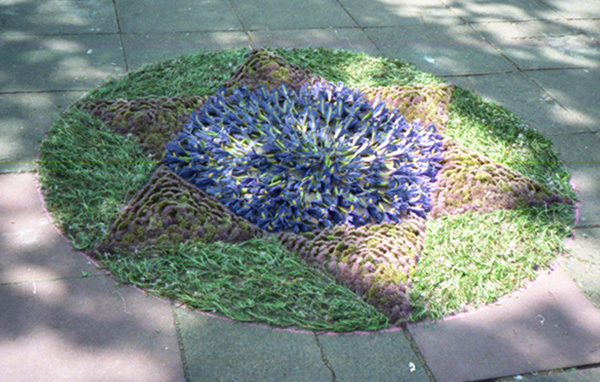
It can be seen briefly in this Hard News documentary (thanks to Kate Wildblood)…
I’ve been told a number of tales about why it never came to be, from the outrage caused by the council’s Pride donation*, to objections about the Pride memorial being so close to the existing war memorial.
* the council gave £5,000 to Pride organisers in 1992, partly to enable disabled access in Preston Park. When that became public knowledge, there was a massive backlash fuelled by the local press, after which the council distanced themselves from Pride altogether.
Unfortunately the main driving force behind the memorial, activist Arthur Law, is no longer with us to ask exactly what happened. If they had pulled it off it would have been a unique and remarkable thing!
Sources consulted to pull this together include my own Painting It Pink!, and the article Forever on our minds from Brighton Ourstory.
